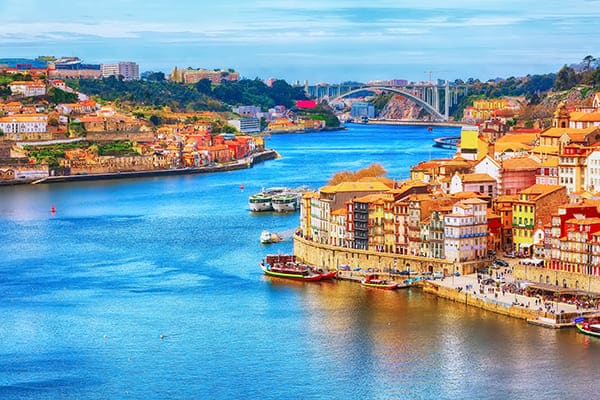Why visit Portugal?


Lisbon
Lisbon, Portugal’s capital, is one the most attractive cities in Europe. This vibrant Atlantic port, located on the banks of the River Tagus, is spread over a series of hills that enhance its spectacular waterfront location. The city’s historic heart is worth exploring. This heritage is best illustrated by the famous Castelo de Sao Jorge, the most significant part of Lisbon, and Alfama, the oldest.
A collection of world-class museums enhances the cultural experience. You can see the modernity of Parque das Nacoes, as well as its attractions like the Oceanario to the east.
To the west, in Belem, Portugal’s golden Age of Discovery can be seen in the stunning Mosteiro dos Jeronimos or the charming Torre de Belem. Both are UNESCO World Heritage Sites.
You can stroll through wide, riverfront esplanades, walk along tree-lined streets, or enjoy jaw-dropping views from the many miradouros (or viewpoints) scattered throughout the city.
Sintra
One of Portugal’s most treasured tourist attractions is Enchanting Sintra. This historic and fascinating town, which UNESCO has recognized for its outstanding cultural landscape, is well worth spending a whole day exploring. It is a popular day trip from Lisbon.
The town lies under the Serra da Sintra hills’ lip. It is dominated by Palacio Nacional. These twin chimneys dominate a square dotted with houses in pale pink and ochre, with a few yellow splashes.
Looking down on this picturesque setting, you can see the Castelo dos Mouros ancient Castelo dos Mouros. It appears to have been carved out of the granite escarpment that it runs. The Palacio da Pena, a charming summer retreat used by the Portuguese royals in the 19th Century, is the crowning jewel of the highest hill.
Sintra has many hiking trails that are suitable for avid walkers. However, you will need to be strong enough to climb the steep hills around the town. The most spectacular views are offered from the highest peaks of the Serra, which overlook the Atlantic coast and distant Cascais.
Porto
Oporto, Portugal’s second-largest city, is known for its robust granite architecture and commercial layout. It offers an entirely different experience than the capital.
Porto, located at the mouth of the River Douro, is a city that has been designated a World Heritage Site by UNESCO. It boasts a riverfront – the Ribeira – and a collection of Neoclassical and Baroque buildings. The needle-shaped Torre dos Clerigos (the city’s cathedral) and the impressive Se are worth mentioning.
Ponte Dom Luis I is another landmark structure. This iconic double-decked, iron bridge spans the Douro. It connects the city to Vila Nova de Gaia. You can stroll down the Ribeira to feel the history and breathe fresh air.
The river is a scenic route that leads to the Douro Valley. This lush landscape features terraced hillsides and villages. One popular option for sightseeing is to take a cruise along the river.
Evora
Evora is a charming destination in Portugal, located in the Alentejo. Evora is a well-known destination for its impressive collection of monuments that are preserved in excellent condition. It deserves a close, unhurried look.
Its medieval walls contain centuries of history. This timeline is illustrated by the impressive Templo Romano, dating back to the second century. The Se (cathedral) from the 12th century is also here. Finally, the Igreja De Sao Francisco with its Capela dos Ossos and lugubrious Capela dos Ossos was completed in the middle-1550s.
Evora’s historical importance and unspoiled architectural heritage have earned it UNESCO World Heritage Site status. You’ll be charmed by the charming market-town atmosphere and down-to-earth personality of Evora. It’s an enjoyable place to shop in its Moorish alleyways, browse engaging museums, and enjoy lunch in beautiful squares. Here you are considered a guest and not a tourist.
Obidos
What gift does a king give his queen as a wedding present for her? It was Obidos, an achingly beautiful town, that the lucky queens of Portugal received. This custom has been in place for hundreds of years. It’s now open to the public and is well worth the hour-long drive from Lisbon.
Obidos is an artist’s dream. A series of cobblestone streets run through Obidos, which are lined with whitewashed houses, cafes, and handicraft shops. They are all completely enclosed by medieval solid walls.
The Igreja De Santa Maria also has a beautiful interior made of 17th-century blue and white azulejos (tiles)
The museum is located in the attractive square of the town and contains rare pieces of art by Josefa de Obidos (17th-century painter).
For stunning views of the terra-cotta roofs and lush plains beyond, you can walk to the tops of the battlements. These fortifications are part of the landmark castle. It keeps towers guardian-like above the picturesque scene below. The court is now a pousada (a period hotel).
Tavira
Tavira is a charming town that has been praised by many as being the best in the Algarve. This laid-back town is adorned with the Rio Gilao, which makes it smile. There’s also a Roman footbridge that connects one side to the other.
The waterfront is a great place to walk before or after discovering the other historical treasures of Tavira. The castle walls offer stunning views of the old town and the coast. The Igreja De Santa do Castelo is a glorious church that houses warrior knights.
A fascinating museum is also located in the town of Nucleo Islamico. One of the highlights is a rare 11th-century figurative vase.
A great option is to visit Ilha de Tavira offshore, especially in the summer heat. This vast beach, even in high seasons, offers plenty of space and is very popular. You can reach it by ferry using a Quatro Aquas jetty.